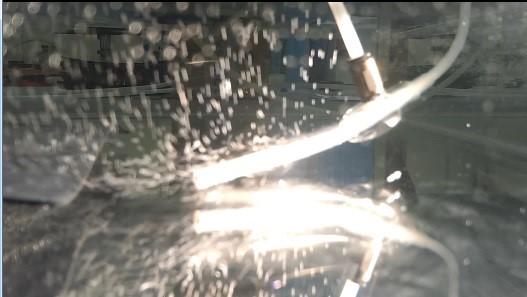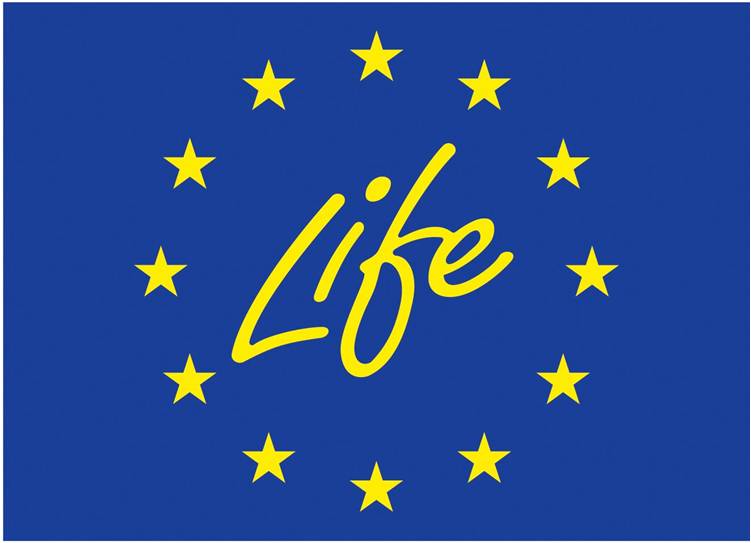ACTION B4 - PROOF OF THE BEST TECHNIQUES FOR BY-PRODUCTS VALORISATION
ACTION B4: PROOF OF THE BEST TECHNIQUES FOR BY-PRODUCTS VALORISATION
Among the products obtained in aquaculture production it is very common to find CO2 proceeding from a combustion system and from native microalgae that are developed in culture tanks open to the atmosphere, facilitate photosynthetic activity due to the reception of ambient light. The growth of microalgae as a subproduct usually occurs spontaneously, but is very favorable for improving the diet of fish and therefore to improve animal welfare and the final quality of the product. Currently the production of microalgae in fattening tanks and adjacent tanks is not optimized and microalgae are only produced by the natural development of these species. This project arises to promote the productivity of microalgae cultivation in tanks designed to this effect, increasing the mix of nutrients and incorporating the organic load from the effluent of a mollusc wastewater treatment that ESTEROS DE CANELA operates in the same locality where they perform the fish farms.
This action therefore leads to a double benefit: to increase productivity of microalgae (and thereby to improve animal welfare and the quality of the final product) and to reduce the organic load of a spill, acting here microalgae as natural purification system. Moreover, it is noteworthy that for microalgae is essential to develop rapidly CO2 dissolution during peak hours of sun. Therefore, in this project, it is foreseen to recover flue gas of a boiler, used to heat water, and of a well whose amount of CO2 dissolved in water is high. To this end, generating CO2 microbubbles devices will be incorporated into a culture of microalgae in photobioreactors, with the aim of producing microalgae as a nutritional supplement for larval fish farming. The boiler, the electrolyzer and photobioreactors will be placed on the fry culture romm in ESTEROS DE CANELA or in a nearby space. Similarly, open tanks (carousel) for microalgae cultivation to be used in the fattening of fish will be located in adjacent to the hatchery (farming fry) of ESTEROS DE CANELA.
This action of demonstration of the best techniques of recovery of products is divided into three tasks:
![]() B.4.1.CO2 fixation through cultivation of microalgae
B.4.1.CO2 fixation through cultivation of microalgae
![]() B.4.2. Optimization of complementary cultivation of microalgae
B.4.2. Optimization of complementary cultivation of microalgae
![]() B.4.3. Assessment of the improvements made by the integrated cultivation of microalgae
B.4.3. Assessment of the improvements made by the integrated cultivation of microalgae
![]() Use of boiler and combustion gases for the dissolution of CO2 in microalgae cultivation. Thus, the GHG emissions associated with the process of heating the water of ESTEROS DE CANELA hatchery will be reduced to less than the half. Disclosure of this activity can make the demonstration of this technology to be introduced in other companies in the aquaculture sector.
Use of boiler and combustion gases for the dissolution of CO2 in microalgae cultivation. Thus, the GHG emissions associated with the process of heating the water of ESTEROS DE CANELA hatchery will be reduced to less than the half. Disclosure of this activity can make the demonstration of this technology to be introduced in other companies in the aquaculture sector.
![]() Enriching the diet of fish minimizing the supply of chemicals needed to ensure their health. Moreover, it will be possible to improve the diet of fishes, which translates into improved animal welfare and the quality of the final product.
Enriching the diet of fish minimizing the supply of chemicals needed to ensure their health. Moreover, it will be possible to improve the diet of fishes, which translates into improved animal welfare and the quality of the final product.
![]() The cultivation of microalgae will improve the quality of effluents in aquaculture facilities due to the reduction of the organic load, which otherwise would be discharged into the natural environment with the consequent problems of chemical, biological oxygen demand (COD and BOD) and eutrophication, thus acting microalgae as natural purification system. The reports made after this activity will give out, in a quantitative manner, the reduction of organic matter in the effluent from fish farms through the incorporation of microalgae.
The cultivation of microalgae will improve the quality of effluents in aquaculture facilities due to the reduction of the organic load, which otherwise would be discharged into the natural environment with the consequent problems of chemical, biological oxygen demand (COD and BOD) and eutrophication, thus acting microalgae as natural purification system. The reports made after this activity will give out, in a quantitative manner, the reduction of organic matter in the effluent from fish farms through the incorporation of microalgae.
![]() The main expected outcome of this task is to present, as a pilot facility, but with documentary support that report on how and when the optimized microalgae polyculture is estimated feasible in aquaculture to complement the regular activities of fish farming. These results will be included in a report which will also include information about the potential for technological improvement and use of technologies of microalgae cultivation for the aquaculture sector to improve efficiency and reduce the environmental impact of this activity.
The main expected outcome of this task is to present, as a pilot facility, but with documentary support that report on how and when the optimized microalgae polyculture is estimated feasible in aquaculture to complement the regular activities of fish farming. These results will be included in a report which will also include information about the potential for technological improvement and use of technologies of microalgae cultivation for the aquaculture sector to improve efficiency and reduce the environmental impact of this activity.
The phytoplankton room at the Esteros de Canela premises has been adapted, as this room shelters the photobioreactors and the preparation of the special diffuser for the CO2 dissolution.
The particular actions carried out within this activity during the first semester 2016 have been the following:
- Once the photobioreactor room has been adapted and the cultivating tubes have been placed, a device for an efficient CO2 transfer has been set up. This device generates micro-bubbles of around 100-micron diameter, which are fully dissolved in the solution to help micro-algae development.
- Once the device is verified for the CO2 dissolution, the room will be set in motion and the micro-algae cultivations will be connected to the fish tanks to feed the zooplankton.
- Once the administrative procedures have been fulfilled, it is the time of constructing the open tank carousel. During the last months, the propulsion system, the building procedures for the central wall and the corresponding deflector gear teeth to reduce the charge loss have been devised.
- According to the activities planned on the project, the only pending action is the connection of the gases evacuation tubes out of the boiler to heat water in the fries tanks with the open carousel. This process is expected to be implemented this autumn, once the open cultivating carousel would be finally built.
 |
 |
| Adaptation of the phytoplankton room and diffuser preparation |





